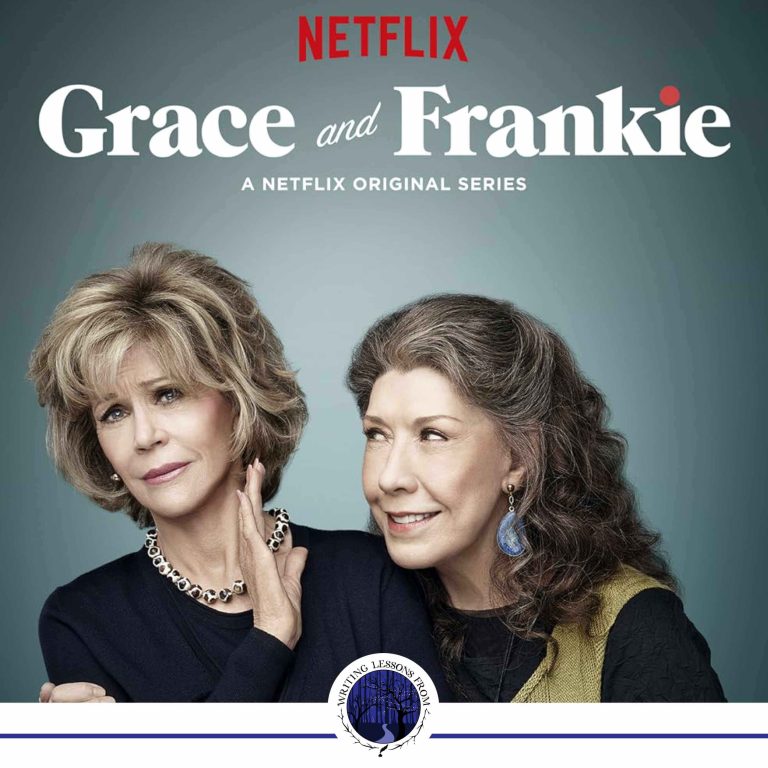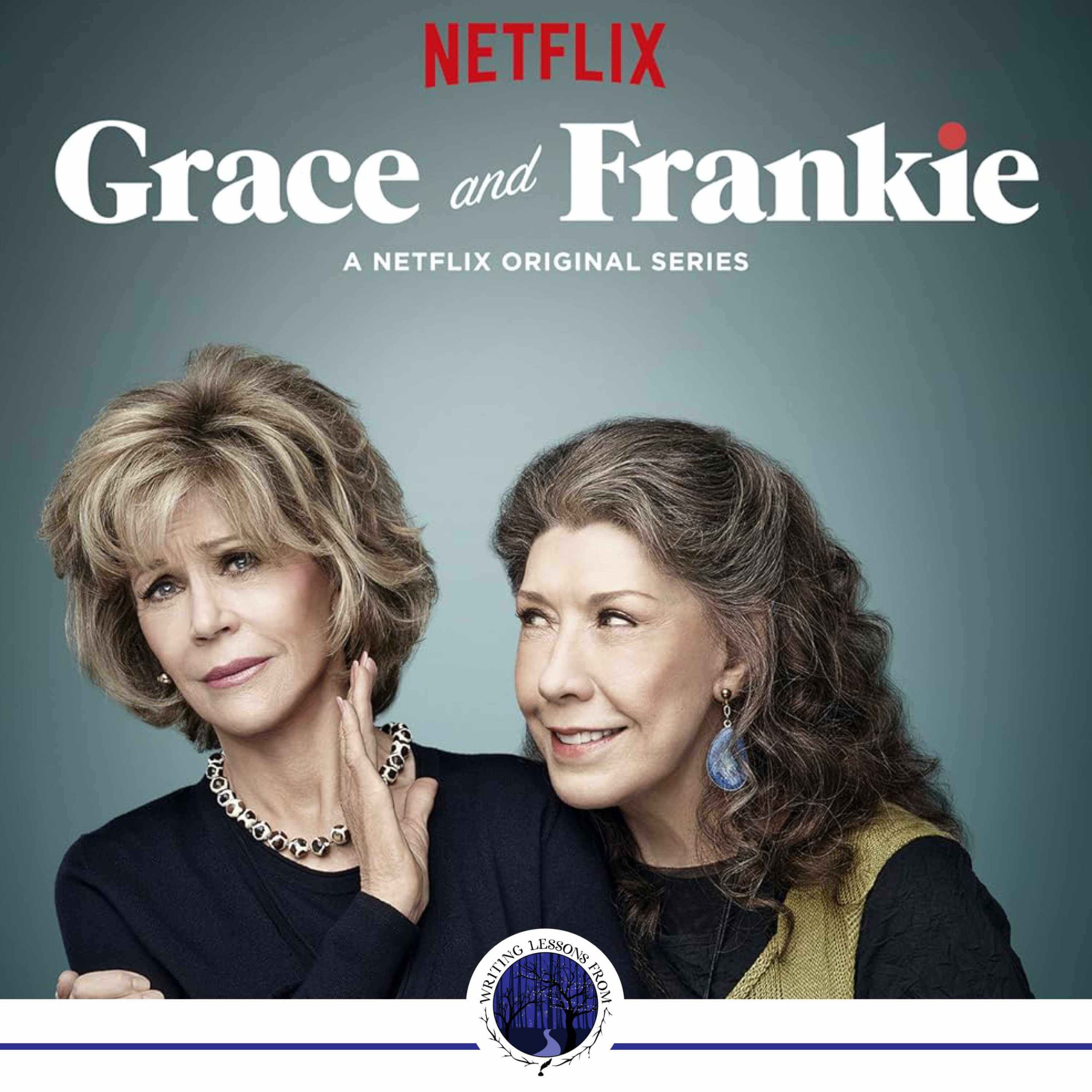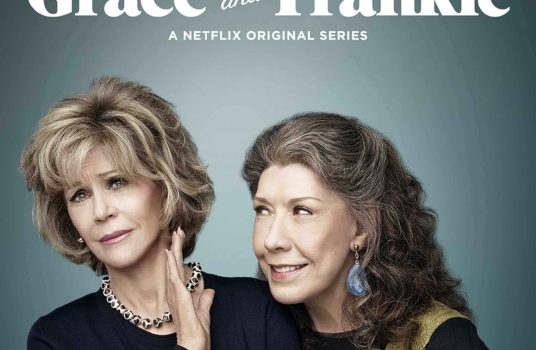Writing Lessons From... Grace and Frankie aka Ending That Story Beautifully
Listen to the blogcast of this episode:
You generally have to be in the mood to consume.
Food. Drink. News.
And stories.
I’ve watched this TV show three times now, and it’s only on the third watch that what I’m talking about today finally hit me.
If there’s one thing I’ve learned (and said) repeatedly on Writing Lessons From…, it’s that endings are hard.
So hard.
On paper, it should be simple. It’s just bringing everything together in an impactful way.
Right?
In practice, it’s so tricky to get right.
We’re looking at endings, so the following contains major spoilers for Grace and Frankie. A show I cannot recommend enough.

First of all, you should go watch Grace and Frankie. As I said, this was my third watch. It’s one of my comfort shows, and I’ll be honest, I’m at a bit of a loss now I’ve finished it.
Again.
As they enter the third act of their lives, Robert and Sol take their wives, Grace and Frankie, to dinner and announce that they’re leaving them, because they’ve fallen in love.
What do you do when your divorce lawyer husbands fall in love and leave you?
Why, you escape to the shared beach house, of course.
Even when, belatedly, you realise that the beach house was bought so they could carry out their affair.
The problem, other than the cheating and lying and not being able to be angry because Robert and Sol are gay and being true to themselves finally, is that Grace and Frankie cannot stand each other.
One is an uptight business woman and alcoholic, and the other is a food-obsessed, drug-taking hippy artist. The perfect odd couple.
Thus begins a beautiful TV show about love, relationships, family, and above all, friendship, led by two best friends, Jane Fonda and Lily Tomlin (who met working on the film, Nine to Five, which becomes important in the final episode).
Okay, we have the set up and we’re seven seasons in
How could this possibly end?
Endings are all about choices.
There are so many ways Grace and Frankie could have ended.
Both could have found love in the arms of new men. One or both could have discovered that they are also gay.
The third option, the one they went with, is so much better.
Grace’s new marriage to billionaire Nick is over, because when faced with losing Frankie from her life, she chooses Frankie over her husband.
Similarly, Frankie discovers she needs Grace just as much.
They choose each other.
To write the ending of your story…
You need to look at four things:
- The themes of the story
- The character arcs
- How it all started
- And make sure there’s closure.
This is what Writing Lessons From… has taught me thus far and Grace and Frankie show these lessons off perfectly.
The themes of the overall story are about growing old and having no regrets.
Robert and Sol want to spend the rest of the lives they have left together, unashamedly, unapologetically in love, but also being true to themselves for the first time.
Similarly, Grace and Frankie refuse to go quietly.
Ignore them and they will scream (and steal, because if you’re invisible, what does it matter?).
They start a business together in their seventies and make a success out of it, advocating for other older women.
They protest and sneak medications over the border and push each other out of their comfort zones to grow and help one another and their friends.
But there’s also a fear of growing old. Especially in the last season, where we watch Frankie lose the ability to hold her paintbrushes and Robert’s memory start to fail.
You know, the terrifying parts of growing old. The idea of losing yourself and what is most precious.
And that leads, of course, to the ultimate fear of ageing: death.
We mix that with the character arcs, taking each character at a time.
Look at how each one has grown: Grace is less uptight and more compassionate, Frankie is becoming more responsible (at times), Brianna has *gulp* feelings and she’s showing them, Mallory has taken charge, Bud is finding permission and freedom, and Coyote has his life truly together for the first time.
What about Robert and Sol?
Honestly, their characters arcs is more a love story, until death do them part. They’ve found their freedom, explored their homosexuality, and are now more in love than ever before.
To figure out where these character arcs end, together with the themes of the show, we have to go back to the beginning.
That very first episode, titled The End, starts with Robert and Sol exploding their two families. It’s the end of their marriages and the breaking of their families, but the start of a new extended family and new adventures.
So it makes sense that the last episode, titled The Beginning, should be a mirror of this.
That’s my favourite type of ending; one that mirrors the beginning.
This whole thing started with Robert and Sol entering a new phase in their love story, so it should end with another new phase, as they work together on living with Robert’s failing memory.
There are endings – Bud’s career, the loss of Grace’s company from the family, Brianna’s relationship, Grace’s second marriage.
And there are new beginnings – Coyote’s marriage, Bud’s new career, Grace helping Frankie find a new way to paint, Brianna and Mallory going into business together.
Just like in that first episode, the last episode is a mixture of endings and beginnings but this time with the emphasis on contentedness instead of broken hearts.
And then, finally, we make sure there’s closure.
Look at that. Everyone’s happy!
Despite the ageing, despite the fear, Robert and Sol are finding a way through with love. Grace is helping Frankie to paint.
The addict has found happiness, the miserable career has been quit, the sisters have learned to work together.
What makes all this work is that these stories are part of the characters arcs that were subtly building up to this ending.
For example, Brianna and Barrie were never going to work out, despite how much they tried. We had hope, but in hindsight they were doomed from the start.
Bud’s story arguably started late, but actually it only came to a head late. From the first series, he was given his fathers’ business and struggling under the weight of the ethics and emotion.
The lessons to take away from all this?
It helps to know where you’re heading.
Have an idea of the direction you’re writing in, where you want everyone to end up, then match it up to the themes and characters.
If you’ve done your job well, your characters will at some point spring to life and muck up any outline you’ve created, so always leave space for them to change direction.
But that doesn’t mean you can’t end up where you want to.
Gently steer them back on course, and if they refuse, add in new obstacles and watch what they do.
If they’re particularly stubborn, it might be that they know of a better ending than the one you came up with, so let them go and follow them.
And in these cases, I often find that the themes and arcs sort themselves out.
I often find that if you have a general direction you want to go in, you don’t have to consciously think about the themes and character arcs. Often, the flow will take you there and you’ll discover it’s all magically matched up.
Then all you have to do is check your work and fill in the gaps, as we’ve discussed here.
Because, usually, our characters know best.
But what if you have no idea what direction you want your characters to go in, and they don’t either?
Take a look at where you started.
If you’re really struggling with your ending, go back to the beginning.
See how far your characters have come and consider putting them back in that original situation. I bet they’d react differently after everything they’ve been through.
Take that as your inspiration.
Follow these four steps, and your characters will find the right ending for their story.
The last lesson from Grace and Frankie?
If in doubt, throw in Dolly Parton.
Because, why not?


